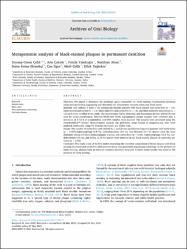| dc.contributor.author | Çelik, Zeynep Ceren | |
| dc.contributor.author | Çakiris, Aris | |
| dc.contributor.author | Yanıkoğlu, Funda | |
| dc.contributor.author | Abacı, Neslihan | |
| dc.contributor.author | Ekmekçi, Sema Sırma | |
| dc.contributor.author | Ilgın, Can | |
| dc.contributor.author | Çelik, Halil | |
| dc.contributor.author | Tağtekin, Dilek | |
| dc.date.accessioned | 2022-03-09T13:59:00Z | |
| dc.date.available | 2022-03-09T13:59:00Z | |
| dc.date.issued | 2021 | en_US |
| dc.identifier.citation | Çelik, Z. C., Çakiris, A., Yanıkoğlu, F., Abacı, N., Ekmekçi, S. S., Ilgın, C., Çelik, H., & Tağtekin, D. (2021). Metagenomic analysis of black-stained plaques in permanent dentition. Archives of oral biology, 128, 105171. DOI: https://doi.org/10.1016/j.archoralbio.2021.105171 | en_US |
| dc.identifier.issn | 0003-9969 | |
| dc.identifier.uri | https://doi.org/10.1016/j.archoralbio.2021.105171 | |
| dc.identifier.uri | https://hdl.handle.net/20.500.12780/478 | |
| dc.description.abstract | Abstract
Objectives: We aimed to determine the aetiologic agent responsible for black staining of permanent dentition using next-generation sequencing and determine the relationship between caries and black stains.
Materials and methods: A total of 52 systemically healthy patients with black-stained and caries-free (n = 13), black-stained and carious (n = 13), black stain-free and caries-free (n = 13), and black stain-free and carious (n = 13) teeth were enrolled in the study. The International Caries Detection and Assessment System (ICDAS II) was used for caries classification. Between 08:00 and 10:00, supragingival plaque samples were collected after a minimum of 8-12 h of accumulation and DNA samples were isolated. The samples were processed using the ZymoBIOMICS™ Service. Bioinformatics analysis was performed using mothur at usegalaxy.org. Data were analysed statistically using the Pearson chi-square and Fisher tests.
Results: The number of caries-free teeth (ICDAS 0, 1, and 2) was significantly higher in patients with black stains (p = 0.007).Capnocytophaga (4.8 %), Corynebacterium (3.9 %), and Neisseria (5.4 %) species were the most abundant among all black-stained plaques (carious and caries-free) (p < 0.05). Capnocytophaga (10.8 %), Cardiobacterium (3.6 %), and Rothia (1.72 %) species were detected in the black-stained plaques of caries-free patients (p < 0.05).
Conclusion: This study is one of the first studies examining the microbial composition of dental plaques with black staining in carious and caries-free adult patients using next generation sequencing technology. In the presence of black staining, plaques have an ultimate complex microbial structure. A lower caries burden was noted in the presence of black staining. | en_US |
| dc.language.iso | eng | en_US |
| dc.publisher | Elsevier | en_US |
| dc.relation.isversionof | https://doi.org/10.1016/j.archoralbio.2021.105171 | en_US |
| dc.rights | info:eu-repo/semantics/closedAccess | en_US |
| dc.subject | Black stain | en_US |
| dc.subject | Dental caries | en_US |
| dc.subject | Next generation sequencing | en_US |
| dc.subject | Oral microbiome | en_US |
| dc.title | Metagenomic analysis of black-stained plaques in permanent dentition | en_US |
| dc.type | article | en_US |
| dc.contributor.department | İstanbul Kent Üniversitesi, Fakülteler, Diş Hekimliği Fakültesi, Klinik Bilimler Bölümü | en_US |
| dc.contributor.institutionauthor | Yanıkoğlu, Funda | |
| dc.identifier.volume | 128 | en_US |
| dc.relation.journal | Archives of Oral Biology | en_US |
| dc.relation.publicationcategory | Makale - Uluslararası Hakemli Dergi - Kurum Öğretim Elemanı | en_US |


















